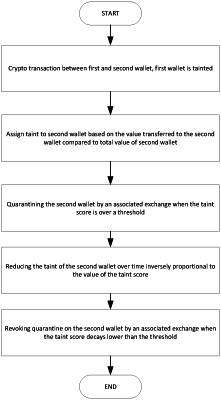| CPC G06Q 20/4016 (2013.01) [G06Q 20/367 (2013.01)] | 6 Claims |

|
1. A method of identifying tainted cryptographic wallets comprising:
mapping a first address to an entity owning private keys to a category associated with a risk level;
clustering the first address into a first wallet based on semi-supervised address classification of shared cryptographic transaction inputs;
assigning the first wallet a first taint score based on the mapping of the first address to the category associated with the risk level of the entity;
identifying a cryptographic transaction between the first wallet and a second wallet on an anonymous blockchain data structure stored in a distributed network, wherein the anonymous blockchain data structure is open for public inspection, wherein the first wallet and the second wallet are represented as nodes in a directed graph constructed based on addresses and transactions associated with the first wallet and the second wallet, the cryptographic transaction having a first amount of cryptocurrency;
determining a total value in cryptocurrency of the second wallet;
assigning a second taint score to the second wallet, wherein the second taint score is a fraction of the first taint score based on a relative comparison between the first amount of cryptocurrency of the cryptographic transaction and the total value in cryptocurrency of the second wallet;
in response to the second taint score being above a threshold, quarantining the second wallet;
reducing the second taint score of the second wallet at a rate inversely proportional to the second taint score; and
in response to reducing the second taint score below the threshold, removing the second wallet from quarantine.
|